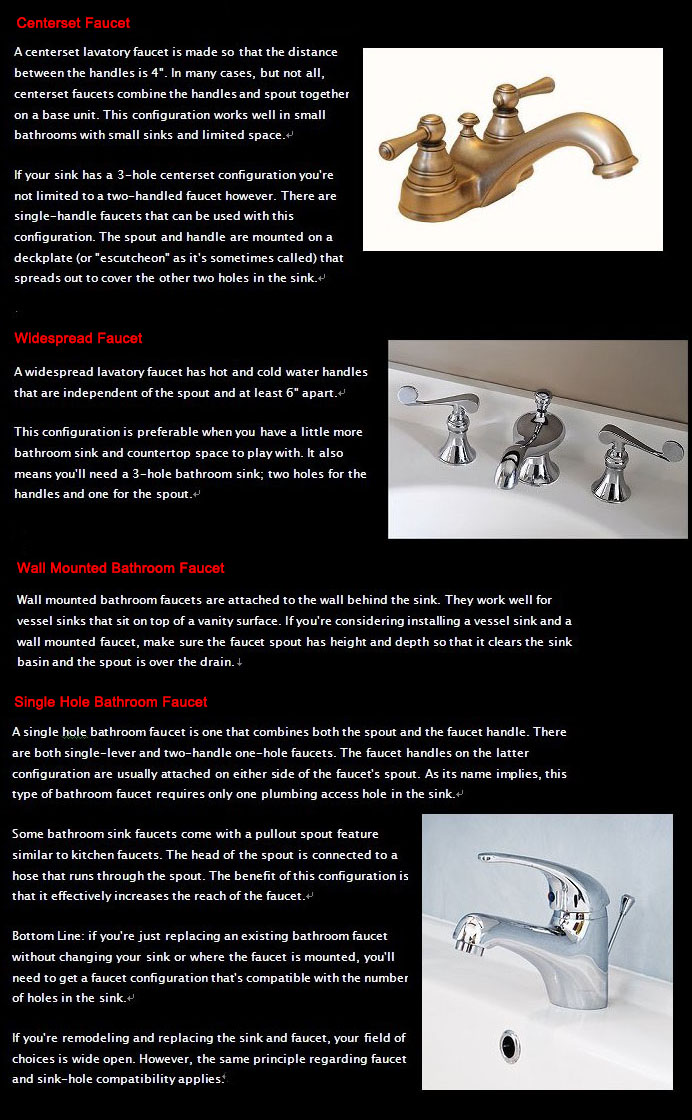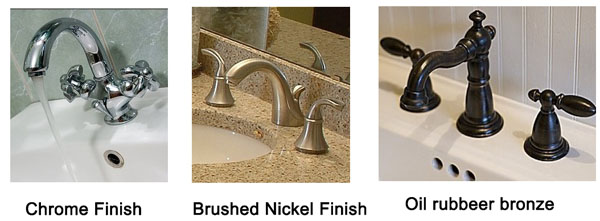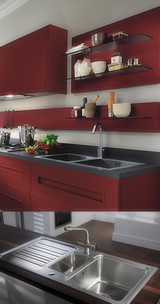Categories
Choose The right Faucet For Your Bthroom
Configuration
Construction/Valve Type
Finish
Style
Bathroom faucets aren't overly complex and the simplest varieties use technology that's been around for decades. On the other hand, there are more complex options with advanced features to choose from too. What you choose is up to you but before you make a decision, it helps to know what's out there.
Learning the Basics of Bathroom Sink Faucets
Bathroom faucets come in a wide variety of styles but beyond pure aesthetics there are a few basic elements you should know about. Understanding them will take most of the mystery out of choosing a faucet and help you arrive at the product that will best suit your particular needs.
There are about 4 primary facets of lavatory faucets you should know about.
Bathroom faucet configuration refers to the broader "type" category that it belongs to. Configuration includes how the faucet is mounted (wall mounted or on the sink), whether it has one or two handles, and how many holes it requires in your sink.
Two terms that you'll often encounter relating to the faucet's configuration are centerset and widespread. These terms refer to the dimension, or how far apart, the holes are in the sink that will accommodate the faucet. For faucets with two handles, these terms also loosely refer to how far apart those handles are with respect to each other and the spout.

The Faucet's Valve Type and Construction
How a bathroom faucet is made and the type of valve it uses are important features to consider when choosing one. A well made faucet with good valve technology can provide you with years of dutiful service.
Brass is a common material used to make the faucet body and spout although some cheap models do use plastic. Brass is normally coated with chrome plating or a PVD finish (see the section on "Finish" below). Without it, brass will tarnish and corrode.
The faucet's valve technology is what actually controls the flow of water. The valve is what really does all the work and has the most moving parts. How it's designed affects how well it performs.
Bathroom faucets use 4 kinds of valve technology: compression,ball, cartridge and ceramic disk. The important point to remember here is that the kind of valve that's used plays a role in its reliability. Reliability equates to how long the faucet works before it starts dripping and needs repair.
Compression valve faucets typically have separate hot and cold water handles. They're the simplest form of faucet valve and they control the flow of water by means of a screw-like feature in the handle that compresses a seal, which is usually a rubber washer. These valves usually wear the fastest and require maintenance sooner than other valve types.
Ball valves are used with single lever faucets. The ball valve has slots in it that control the mixture and the amount of hot and cold water that's allowed through the spout. Moving the handle changes the position of these slots within the valve which regulates the flow. These valves don't use washers like compression valves but they have more parts making them more complex.
Cartridge valve bathroom faucets utilize a hollow sleeve attached to the water supply that moves inside another sleeve. Movement of the faucet handle moves these sleeves relative to each other, aligning or blocking holes that control the supply of water. They have fewer moving parts than a ball valve but they do have seals that can wear out and require replacement.
Ceramic disc faucet valves make use of two hard, highly polished ceramic disks that slide relative to each other. The motion between the two disks controls the flow of water by opening or restricting the pathway for the water. Although they're typically more expensive, ceramic disk valves are considered the most durable and longest-lasting type of faucet valve
A bath faucet's finish is the outer surface treatment that's applied to all the exterior parts. Besides the protection that it offers the base material, the finish also gives the faucet its "color".



